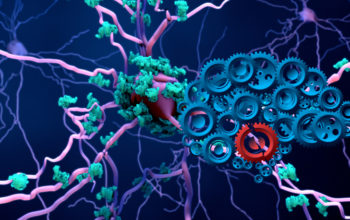
Date: 16th October 2019
New immunotherapy anti-cancer platform using CRISPRa helps the immune system detect cancerous cells.
CRISPR-derived therapies are rapidly evolving to meet the everyday need for treatments in the clinic.
Last week we reported encouraging data that CRISP-Cas9 nanoparticles had been used to eliminate cervical cancer tumours in mice.
This week, a Cas13-derived platform hit our news in the development of antiviral strategies, which detect and destroy single-stranded RNA viruses in human cells.
Now scientists have exploited CRISPR activation (CRISPRa) to directly augment expression of endogenous genes encoding tumor-associated antigens, leading to a more pronounced antitumor immune response.
An essential step in cancer immunotherapy is the recognition of tumour-associated antigens which are typically the product of cumulative genetic and epigenetic aberrations. If presented at sufficient levels, these antigens can illicit an immune response and lead to elimination of cancerous cells from the body.
However, in many cases the presentation of mutated antigens does not occur at a level sufficient for the immune system to activate, meaning that the cancer persists as undetected by the body.
In order to allow the immune system to more readily detect cancer cells in such cases, researchers from Yale University, US, have developed an approach called Multiplexed Activation of Endogenous Genes as an Immunotherapy (MAEGI). This system is based on CRISPR activation (CRISPRa) and utilises a ‘dead’ Cas9 (dCas9) linked to a transcriptional activator along with a pool of guide RNAs that target multiple genes.
Put simply this work, published in Nature Immunology, demonstrates that the system was able to activate the expression of tumour-related antigens so that cancerous cells became more visible to the immune system and subsequently elicited an immune response which led to higher levels of tumour clearance.
CRISPRa targeting and tumour clearance
Initial validation work in the publication showed CRISPRa enhancement of antigen presentation using a model antigen transgene, the result demonstrated promotion of T-cell effector function in cell lines.
Complexity was then added to the system by introducing the multiplexing element using a sgRNA library and assessing the ability of the system to activate endogenous gene activation.
The CRISPRa-transduced cancer cells were transplanted in to both immunocompetent and immunodeficient mice to determine the immunogenicity of the cancer cells.
Whilst all control mice displayed large tumours, 84% of the immunocompetent mice rejected the cell pools and the remaining mice showed only small tumours. In sharp contrast, all immune-comprised mice showed large tumour growths. Furthermore, if T-cells were depleted in the immunocompetent mice prior to transplantation, large tumours were then able to grow.
The results indicated that pooled activation of endogenous genes induced potent rejection of tumours and a functioning immune system was required in order for this to occur.
Efficient delivery
An important component of any immunotherapy regime is safe delivery. To address this, the authors used adeno-associated viruses (AAVs), viral vectors capable of mediating transgene delivery of CRISPRa directly into target tumours. AVV’s are currently the main viral vector used in the pursuit of gene therapies, as they are considered non-pathogenic to humans, and have modified to prevent its integration into the genome.
The AAV-CRISPRa was shown to be effective at delivering its cargo, activating gene expression of the mutated ‘tumour’ genes and enabling immune clearing of a large fraction of established tumour at both local and distant sites and in a range of cancer types.
CRISPRa as a therapeutic tool
MAEGI is an entirely new form of immunotherapy, and offers an exciting tool for the future. Many cancers are able to either down-regulate antigen presentation in order to ‘escape’ the immune response or simply they present antigens at low levels and MAEGI offers a promising way to support the host immune response in these cases.
With AAV now an FDA-approved therapeutic transgene vector, MAEGI lends its well for translation into the clinic. Whilst the road to human trials is still being explored, it will require many more steps to assess the potential harmful effects of over-expressing cancer-related genes, evaluation of toxicity, optimisation of delivery for example.
Recently we reported how CRISPRa was being used to increase protein yields in the context of biomanufacturing. Now with this new publication the diversity of CRISPRa applications is really coming to light. With the availability of these research tools readily in place we are sure that other fields will be looking more closely into their use and we will be keeping a close eye out for the next first-in-its-kind breakthrough.
For more information please read the press release.
Wang, G., R. D. Chow, Z. Bai, L. Zhu, Y. Errami, X. Dai, M. B. Dong, L. Ye, X. Zhang, P. A. Renauer, J. J. Park, L. Shen, H. Ye, C. S. Fuchs and S. Chen (2019). “Multiplexed activation of endogenous genes by CRISPRa elicits potent antitumor immunity.” Nature Immunology.
https://doi.org/10.1038/s41590-019-0500-4



